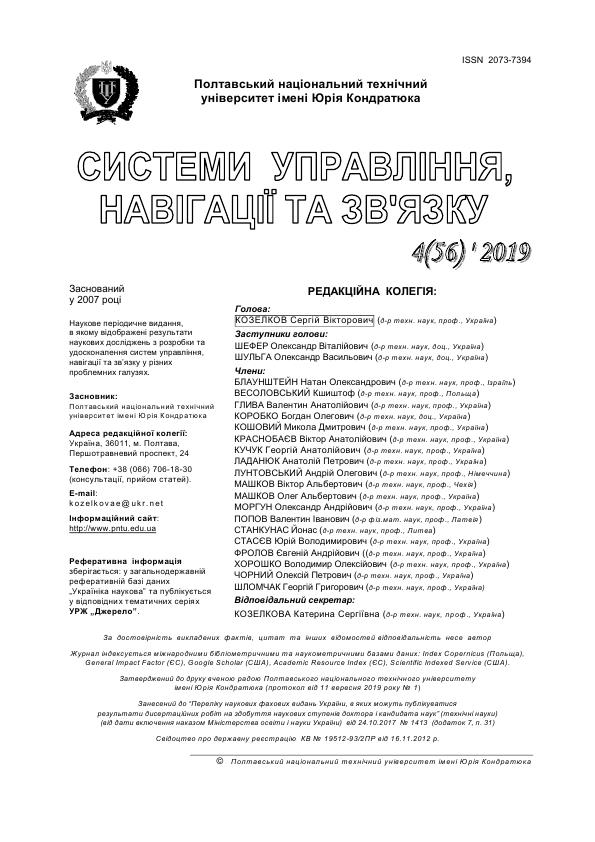REDUCING THE ACCURACY OF MEASURING FREQUENCY OF THE RADIO PULSE BURST DUE TO THE INFLUENCE OF THE CONDITIONS OF ITS PROPOGATION AND REFLECTION
DOI:
https://doi.org/10.26906/SUNZ.2019.4.130Keywords:
radar surveillance, coherent pulse radar, burst of radio pulses, phase fluctuations, Gaussian noiseAbstract
The accuracy of the measurement of the burst frequency for case of coordinated processing without taking into account the phase fluctuations is evaluated in this article. Results are demonstrated of experiment on determination of statistical characteristics of radar's signals, reflected from local objects, located outside distance of direct visibility, at propagation of radio waves in the conditions of anomalous refraction above a sea. The obtained histograms of the distribution of the initial phase of the reflected signal of the radar are fitted with a curve corresponding to the normal distribution, and the normalized correlation function has an oscillating character. The signals at the input of the radar’s receiver is an additive mixture of signals reflected from the targets, and uncorrelated Gaussian noise, that is the assumption of investigating. It is assumed, that the phase fluctuations of the received radio pulses bursts are distributed according to normal probability laws with zero mean, and correlations of phase fluctuations decrease with alternating, sign-variable laws by increasing interval between radio pulses within the bursts. The frequency of radio signal is estimated by the maximum criterion of the natural logarithm of the likelihood ratio. An explicit expression is obtained a sufficient statistics during the presence of phase fluctuations. The results show that under condition of a regular measurement, the accuracy of measuring the frequency of a burst of radio pulses is much more affected by the statistical characteristics of phase fluctuations than the signal-to-noise ratio in modern radars.Downloads
References
Ермолаев В. Т. Теоретические основы обработки сигналов в беспроводных системах связи: Монография / В. Т. Ермолаев, А. Г. Флаксман. — Нижний Новгород: Изд-во ННГУ им. Н.И. Лобачевского, 2011. — 368 с.
Бакулин М .Г. Технология MIMO: принципы и алгоритмы/ М. Г. Бакулин, Л. А. Варукина, В. Б Крейнделин. М.: Горячая линия-Телеком, 2014. — 244с.
Linebarger D. A. The effect of spatial averaging on spatial correlation matrices in the presence of coherent signals/ D A. Linebarger, D. H. Johnson// IEEE Trans.on ASSP. –1990. –Vol. 38, No. 5. –P. 880-884.
Семеняка А. В. О методах оценивания теплицевых корреляционных матриц в задачах адаптивной пространственновременной обработки сигналов/ А. В. Семеняка, Д. С. Рачков, Д.И . Леховицкий// Прикладная радиоэлектроника: науч.-техн. журнал. – 2011. – Т. 10, № 4. – C. 441–447.
Василишин В. И. Предварительная обработка сигналов с использованием метода SSA в задачах спектрального анализа / В .И. Василишин // Прикладная радиоэлектроника: науч.-техн. журнал. – 2014. – Том 13, № 1. – С. 43–50.
Василишин В. И. Комбинированная пеленгация источников шумового излучения с использованием псевдошумового размножения выборки/ В. И. Василишин // Системи обробки інформації.— Х.: ХУПС, 2017. — Вип. 1 (147). — С. 50–53
Vallet P. Toeplitz rectification and DOA estimation with MUSIC / P. Vallet, P. Loubaton // Proc. of 2014 IEEE International Conference on Acoustic, Speech and Signal Processing (ICASSP). —2014. — P. 2237-2241.
Gorokhov A. Unified analysis of DOA estimation algorithms for covariance matrix transforms / A. Gorokhov, Yu. Abramovich, J.F. Böhme// Signal Processing. —1996.—Vol 55.— P. 107-115




